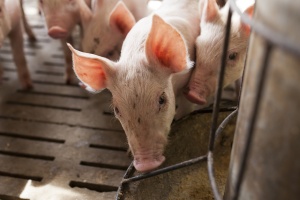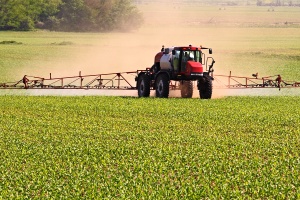Working to Farm – A day in the life of Drew Kuhn
Let’s get to know 30-year-old Drew Kuhn from Genoa, IL, a production manager for Sturtevant Hog Farms. Drew faces a scenario that isn’t uncommon for the next generation of farmers: a desire to work for the family farm, but an economy that requires off-farm income to pay the bills. By day, Drew works for another family’s farm business that raises 80,000 wean-to-finish pigs each year. Pigs arrive at about 3 weeks old, and are raised in multiple barns by people like Drew until they reach market size, spending roughly 5 months in his care. On nights and weekends, Drew helps at his own family’s pig farm, alongside his dad and brother, raising pigs and growing corn and soybeans.

6:30 a.m.: I get on the road, having already spent an hour on paperwork this morning, and start my daily trek to check pig barns in Shannon, a small town 120 miles west of Chicago. Today I’ll be in finishing barns, with pigs just a few weeks away from going to market.
It’s a foggy, wet morning, but I could drive this route in my sleep. I’ve done it 5 days a week since starting this job four and a half years ago. I pass the time with the latest episode of “The Way I heard it.” I like Mike Rowe. I like even more that it’s a 10-minute podcast. You can only listen to someone talk for so long.

8 a.m.: The fog lifts by the time I pull into the barn’s driveway. Our barns are sleek, and come with all the bells and whistles for raising pigs indoors: automated curtains for temperature control, precision feeders, water trackers and so on.
Inside, I grab a pair of coveralls from a wall hook and slip on rubber work boots in a small, clean room that sits adjacent to where the pigs are kept. This is our biosecurity protocol, designed to minimize the spread of illness between barns.
In the barn, I move from pen to pen – looking for anything out of the ordinary. Pigs with coughs, sore joints, or that are lethargic and don’t want to get up, or others that look a little thin from lack of appetite.
It’s a slow, deliberate process so that every animal can be monitored. Health can change quickly, even from one day to the next, and can impact an entire barn. It’s critical to determine if a pig needs on-the-spot treatment or should be moved to the sick pen to recover.
But this is a healthy group. I climb a rail from one pen to the next; the pigs scurry for a moment, but curiosity gets the best of them. They closely follow as I make my way around the pens. They’re familiar with me, which they show by nipping at my coveralls. I like to think it’s a sign of affection.
I head back to the room I started in, slip off my boots and rehang the coveralls where I found them. There are no medical issues to note today, so I head out.
8:30 a.m.: I’m back in the car, starting the 20-minute journey to the next barn. My day is a 70/30 split: 70 percent is in the car driving to and from sites and 30 percent is in the barn. Hence, the podcasts for entertainment. My wife likes to joke with me: “How can you be tired? You drove around all day.”

9 a.m.: Barn #2 is a little newer than the last. In another small room connected to the barn, I repeat my biosecurity process: coveralls up, boots on. In the hallway is a panel. It’s controlling temperature, maintaining the barn around 70 degrees. Pigs are particularly picky about the temperature of their environment, which is one of the perks to living inside a barn like this one. If it gets too warm, those automatic curtains lining the sides of the barn open to let cooler air in. And the water intake tracker helps us catch illness early. If the water levels dip, it might indicate sickness, allowing my crew to proactively provide care.
Inside the barn I make my rounds again – checking for soreness, lethargy, illness. A white chute connected to white pipes near the ceiling periodically drops feed into troughs in each pen, another automated function that allows us to focus more on the health and well-being of the animals.
9:30 a.m.: Back in the car, I head for a third barn, one that was constructed less than a year ago. It’s the mecca of pig barn technology.
Coveralls, check. Boots, check. I head over to an even larger panel than the last barn. This controller monitors similar things: barn temperature, water and feed consumption – but also biosecurity and electricity use. And it’s connected to mobile, so what’s happening in the barn is monitored in real time, and with the touch of a screen. If something out of the ordinary happens, an alert is sent to Chad – who lives about 100 yards from the barn – so he can check on things almost immediately.

Speaking of Chad, he stops in. He and his wife, Julia, are in coveralls, too, while their three boys shuffle around in mini rubber work boots. The kids are right at home with these animals. Chad and I chat while Julia and the two smallest make their own rounds. The oldest stays by dad.

10 a.m.-3 p.m.: The day continues like the first three stops. It’s been relatively uneventful. No need to administer medication, or move a pig to a sick pen. It’s a good day. My rounds wrap up at 3 p.m., but the day’s not over yet. I make the 60-mile drive back to Genoa and head to my dad’s house, which isn’t too far from my own.

4:30 p.m.: Dad’s farm is smaller than the one I work for, about 2,200 piglets that get raised to adults. Barn work is done for the day, but I do a quick walk through the nursery anyway. Then, talk shop with my dad and brother over dinner.

The end goal is for this to be my full-time job – working the family farm with my brother, who likes the crop side of the business. Right now, the farm doesn’t provide enough income to support two more families. It’s a scenario we’re working through: what it will take to make it a viable option, like adding more barns. It would be a big investment. Even for a family with deep farming roots, we have to make smart, strategic decisions to ensure a successful future for each of us.

So until then, I’ll keep making the daily trek, checking pigs and doing what I love.










Cindy Nagel Strasser said:
Posted on at 18:01